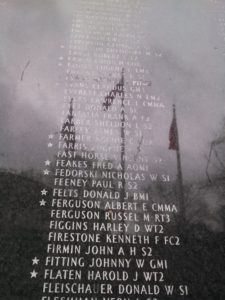In late July 1945, the USS Indianapolis steamed straight toward the Philippines. The ship and its crew of 1195 servicemen had just delivered parts of an atomic bomb in Guam on a secret mission, and were to rendezvous with the USS Idaho in Okinawa for a joint attack on Japan.

Russell Myers Ferguson, RT3, was in the radio tower. Russell, from Philadelphia, PA, had joined the Navy in 1943; he’d seen active duty in the Pacific for his entire tour so far.

Russell Ferguson was just 22 years old.
Out on the open sea just after midnight, in the dark, most of the crew were asleep. No enemy activity detected, the ship slowed down to 17 knots, and continued directly on course.

But underneath the silent surface, Japanese submarine I-58 had located the Indy. At 00:15 on July 30, Commander Mochitsura Hashimoto ordered 6 torpedoes to be fired on their enemy.
Taking 2 hits to the starboard side, the USS Indianapolis broke into pieces, and rolled completely over. With bow in the air, the ship sank.
In just 12 minutes, the USS Indianapolis was gone.
The estimated number of initial servicemen survivors is put around 900, though no one knows for sure. Many were floating in the oil slick and debris without life jackets. Only a few rafts dotted the inky waves, filled with our wounded and shocked sailors.
By the time a random patrol plane pilot happened to fly over the area four days later, just 316 crewmen had lived through dehydration, shock, exposure, injury, and the terrorizing agony of frenzied, relentless shark attacks.
The Navy’s official statement to this day is that a distress signal must not have been radioed out from the attacked ship because no distress call was picked up at any time, by any receivers across the Pacific. (Declassified documents have since shown that at least three separate calls were received.)

After the USS Indianapolis remnant was rescued, and world war aggression had ceased, the Ferguson family held a memorial service for their beloved Russell, their only son.
“Life’s race well run, Life’s work well done, Life’s crown well won, Now comes rest,” they had printed on his memorial program, December 30, 1945.
His baby sister, Alice, was just 12. She adored her big brother Russell, and though she missed him, the harsh reality of his passing hadn’t really hit her.
She remembered her grieving parents, and all their friends and family singing hymns and sharing happy stories of Russell. She remembered that they talked about how much Russell loved God and the Bible.
She remembered watching the pretty young girl Russell had been sweet on, whose name Alice couldn’t remember, who was still pretty despite her sadness.
And as an elderly woman, just before she died, Alice told me of one other memory from that day.
She said that after the ceremony, three somber young sailors in crisp white uniforms approached her parents. They expressed their deep condolences. They were shipmates of Russell’s, from the USS Indianapolis.

These three had survived the attack, the shock, the injuries, and the sharks.
Then they assured Mr. and Mrs. Ferguson, that they had been near Russell – who was on radio duty – during the torpedo blasts that sunk the ship.
And beyond a shadow of a doubt, they said, Russell and the other radio operators had radioed the distress call in. Not once, not twice, but over and over. Russell went down into the water still at the radio.
During the 12 minutes that it took for the ship to sink, Russell was desperately sending the SOS call over the radio, they said.
Whether he survived the initial sinking has been lost to time.
I’d like to think that his life’s race finished inside the radio tower, in that 12 minutes, still doing his duty to the end, just like his friends remarked.
July 30, 2018, marks the 73rd anniversary of the USS Indianapolis tragedy. Maria Bullard of the USS Indianapolis Second Watch Organization points out something unique about this year: “…the calendar is the same as it was in 1945, in that the sinking happened minutes after midnight on Sunday Night/Monday Morning, and the rescue began midday Thursday. So as we enter the week this year, it will be on the same exact days.”
Less than 30 survivors remain alive today. If you know of any survivors or their families, thank them for their service. You could also contact the Second Watch Organization – the family, friends, and supporters of the men of the USS Indianapolis. For a first-hand account, read “OUT OF THE DEPTHS” by Edgar Harrell, USMC.
On April 25, 2015, the USS Indianapolis Memorial flew the flag in honor of Russell Ferguson, RT3. This flag has been passed on to Alice’s son – Russell’s namesake – because she never remembered a time that the Navy presented a flag to her parents in Russell’s memory.

This memorial means a great deal to me, because Russell was my grandmother’s cousin.
Our family’s descendants through the generations will never forget him.


Enjoyable read. World Magazine reviewed a book recently on this tragedy.
Thank you! Yes, that article includes an excerpt from the book, “INDIANAPOLIS: The True Story of the Worst Sea Disaster in U.S. Naval History and the Fifty-Year Fight to Exonerate an Innocent Man,” by Lynn Vincent and Sara Vladic, which looks really good. It references Edgar Harrell, the author of the autobiography I mentioned.